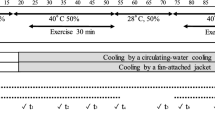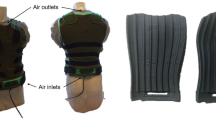Abstract
Electric fan use in extreme heat wave conditions has been thought to be disadvantageous because it might accelerate heat gain to the body via convection. However, it has been recently shown that fan use delays increases in heart rate even at high temperatures (42 °C) in young adults. We here assess the biophysical and physiological mechanisms underlying the apparently beneficial effects of fan use. Eight males (24 ± 3 y; 80.7 ± 11.7 kg; 2.0 ± 0.1 m2) rested at either 36 °C or 42 °C, with (F) or without (NF) electric fan use (4.2 m/s) for 120 min while humidity increased every 7.5 min by 0.3 kPa from a baseline value of 1.6 kPa. Heart rate (HR), local sweat rate (LSR), cutaneous vascular conductance (CVC), core and mean skin temperatures, and the combined convective/radiative heat loss (C+R), evaporative heat balance requirements (Ereq) and maximum evaporative potential (Emax) were assessed. C+R was greater with fan use at 36 °C (F 8 ± 6, NF 2 ± 2 W/m2; P = 0.04) and more negative (greater dry heat gain) with fan use at 42 °C (F −78 ± 4, NF −27 ± 2 W/m2; P < 0.01). Consequently, Ereq was lower at 36 °C (F 38 ± 16, NF 45 ± 3 W/m2; P = 0.04) and greater at 42 °C (F 125 ± 1, NF 74 ± 3 W/m2; P < 0.01) with fan use. However, fan use resulted in a greater Emax at baseline humidity at both 36 °C (F 343 ± 10, NF 153 ± 5 W/m2; P < 0.01) and 42 °C (F 376 ± 13, NF 161 ± 4 W/m2; P < 0.01) and throughout the incremental increases in humidity. Within the humidity range that a rise in HR was prevented by fan use but not without a fan, LSR was higher in NF at both 36 °C (P = 0.04) and 42 °C (P = 0.05), and skin temperature was higher in NF at 42 °C (P = 0.05), but no differences in CVC or core temperatures were observed (all P > 0.05). These results suggest that the delayed increase in heart rate with fan use during extreme heat and humidity is associated with improved evaporative efficiency.


Similar content being viewed by others
References
Adams WC, Mack GW, Langhans GW, Nadel ER (1992) Effects of varied air velocity on sweating and evaporative rates during exercise. J Appl Physiol 73:2668–2674
Alber-Wallerström B (1985) Efficiency of sweat evaporation in unacclimatized man working in a hot humid environment. Eur J Appl Physiol 54:480–487
Basu R, Ostro BD (2008) A multicounty analysis identifying the populations vulnerable to mortality associated with high ambient temperature in California. Am J Epidemiol 168:632–637. doi:10.1093/aje/kwn170
Berglund LG, Gonzalez RR (1977) Evaporation of sweat from sedentary man in humid environments. J Appl Physiol 42:767–772
Bouchama A, Dehbi M, Mohamed G, et al. (2007) Prognostic factors in heat wave-related deaths: a meta-analysis. Arch Intern Med 167:2170–2176. doi:10.1001/archinte.167.20.ira70009
Candas V, Libert JP, Vogt JJ (1979b) Influence of air velocity and heat acclimation on human skin wettedness and sweating efficiency. J Appl Physiol 47:1194–1200
Candas V, Libert JP, Vogt JJ (1979a) Human skin wettedness and evaporative efficiency of sweating. J Appl Physiol 46:522–528
CDC (2004) Extreme heat: a prevention guide to promote your personal health and safety. http://www.bt.cdc.gov/disasters/extremeheat/heat_guide.asp. Accessed 2 Apr 2013
Clifford J, Kerslake DM, Waddell JL (1959) The effect of wind speed on maximum evaporative capacity in man. J Physiol 147:253–259
Cui J, Wilson TE, Crandall CG (2002) Phenylephrine-induced elevations in arterial blood pressure are attenuated in heat-stressed humans. Am J Phys Regul Integr Comp Phys 283:R1221–R1226. doi:10.1152/ajpregu.00195.2002
DuBois D, Dubois E (1916) A formula to estimate surface area if height and weight are known. Arch Intern Med 17:863
Fanger, PO (1967) Calculation of thermal comfort: introduction of a basic comfort equation.
Fouillet A, Rey G, Laurent F, et al. (2006) Excess mortality related to the August 2003 heat wave in France. Int Arch Occup Environ Health 80:16–24. doi:10.1007/s00420-006-0089-4
Gagge AP (1937) A new physiological variable associated with sensible and insensible perspiration. Am J Physiol - Leg Content 120:277–287
Gagge AP, Herrington LP, Winslow C-EA (1937) Thermal interchanges between the human body and its atmospheric environment. Am J Epidemiol 26:84–102
Gagnon D, Kenny GP (2011) Sex modulates whole-body sudomotor thermosensitivity during exercise. J Physiol 589:6205–6217. doi:10.1113/jphysiol.2011.219220
Gorman AJ, Proppe DW (1982) Influence of heat stress on arterial baroreflex control of heart rate in the baboon. Circ Res 51:73–82. doi:10.1161/01.RES.51.1.73
Gupta S, Carmichael C, Simpson C, et al (2012) Electric fans for reducing adverse health impacts in heatwaves. In: Cochrane Database of Systematic Reviews. John Wiley & Sons, Ltd
Hajat S, O’Connor M, Kosatsky T (2010) Health effects of hot weather: from awareness of risk factors to effective health protection. Lancet 375:856–863. doi:10.1016/S0140-6736(09)61711-6
Hardy JD, Stolwijk JA (1966) Partitional calorimetric studies of man during exposures to thermal transients. J Appl Physiol 21:1799–1806
Hartz DA, Golden JS, Sister C, et al. (2012) Climate and heat-related emergencies in Chicago, Illinois (2003–2006). Int J Biometeorol 56:71–83. doi:10.1007/s00484-010-0398-x
Inoue Y, Nakao M, Araki T, Murakami H (1991) Regional differences in the sweating responses of older and younger men. J Appl Physiol 71:2453–2459
Jose AD, Stitt F, Collison D (1970) The effects of exercise and changes in body temperature on the intrinsic heart rate in man. Am Heart J 79:488–498. doi:10.1016/0002-8703(70)90254-1
Kamon E, Avellini B (1976) Physiologic limits to work in the heat and evaporative coefficient for women. J Appl Physiol 41:71–76
Kamon E, Belding HS (1971) Heart rate and rectal temperature relationships during work in hot humid environments. J Appl Physiol 31:472–477
Kenefick RW, Cheuvront SN (2012) Hydration for recreational sport and physical activity. Nutr Rev 70:S137–S142. doi:10.1111/j.1753-4887.2012.00523.x
Kenney WL, Hodgson JL (1987) Heat tolerance, thermoregulation and ageing. Sports Med 4:446–456. doi:10.2165/00007256-198704060-00004
Kenney WL, Mikita DJ, Havenith G, et al. (1993) Simultaneous derivation of clothing-specific heat exchange coefficients. Med Sci Sports Exerc 25:283–289
Kenney WL, Zeman MJ (2002) Psychrometric limits and critical evaporative coefficients for unacclimated men and women. J Appl Physiol 92:2256–2263. doi:10.1152/japplphysiol.01040.2001
Kerslake DM (1972) The stress of hot environments. Cambridge University Press, Cambridge
Kravchenko J, Abernethy AP, Fawzy M, Lyerly HK (2013) Minimization of heatwave morbidity and mortality. Am J Prev Med 44:274–282. doi:10.1016/j.amepre.2012.11.015
Lancet T (2015) Health professionals: be prepared for heatwaves. Lancet 386:219. doi:10.1016/S0140-6736(15)61261-2
Luber G, McGeehin M (2008) Climate change and extreme heat events. Am J Prev Med 35:429–435. doi:10.1016/j.amepre.2008.08.021
Matthies F, Bickler G, Marin N, Hales S (2008) Heat-health action plans. World Health Organization, Europe
Mekjavic IB, Rempel ME (1990) Determination of esophageal probe insertion length based on standing and sitting height. J Appl Physiol 69:376–379
Mitchell D (1974) Convective heat loss from man and other animals. In: Monteith JL, Mount LE (eds) Heat loss from animals and man. Butterworths, London
Nelson NA, Shelley WB, Horvath SM, et al. (1948) The influence of clothing, work, and air movement on the thermal exchanges of acclimatized men in various hot environments. J Clin Invest 27:209–216. doi:10.1172/JCI101935
Nitschke M, Tucker GR, Hansen AL, et al. (2011) Impact of two recent extreme heat episodes on morbidity and mortality in Adelaide, South Australia: a case-series analysis. Environ Health 10:42. doi:10.1186/1476-069X-10-42
Parsons K (2002) Human thermal environments: the effects of hot, moderate, and cold environments on human health, Comfort and Performance, 2nd edn. CRC Press
Ramanathan NL (1964) A new weighting system for mean surface temperature of the human body. J Appl Physiol 19:531–533
Ravanelli NM, Havenith G, Hodder S, Jay O (2015) Heart rate and body temperature responses to extreme heat and humidity with and without electric fans. J Am Med Assoc 313:724–725
Rowell LB, Brengelmann GL, Blackmon JR, Murray JA (1970) Redistribution of blood flow during sustained high skin temperature in resting man. J Appl Physiol 28:415–420
Salamanca F, Georgescu M, Mahalov A, et al (2014) Anthropogenic heating of the urban environment due to air conditioning. J Geophys Res Atmos 2013JD021225. doi:10.1002/2013JD021225
Schuman SH (1972) Patterns of urban heat-wave deaths and implications for prevention: data from New York and St. Louis during July, 1966. Environ Res 5:59–75. doi:10.1016/0013-9351(72)90020-5
Shibasaki M, Umemoto Y, Kinoshita T, et al. (2015) The role of cardiac sympathetic innervation and skin thermoreceptors on cardiac responses during heat stress. Am J Physiol Heart Circ Physiol 308:H1336–H1342
Smith CJ, Kenney WL, Alexander LM (2013) Regional relation between skin blood flow and sweating to passive heating and local administration of acetylcholine in young, healthy humans. Am J Phys Regul Integr Comp Phys 304:R566–R573. doi:10.1152/ajpregu.00514.2012
Victorian Government Department of Health (2013) Residential aged care services heatwave ready resource. Ageing and Aged Care, Melbourne
Whitman S, Good G, Donoghue ER, et al. (1997) Mortality in Chicago attributed to the July 1995 heat wave. Am J Public Health 87:1515–1518
WHO (2009) Improving public health responses to extreme weather/heat-waves—EuroHEAT
Wingo JE, Low DA, Keller DM, et al. (2010) Skin blood flow and local temperature independently modify sweat rate during passive heat stress in humans. J Appl Physiol 109:1301–1306. doi:10.1152/japplphysiol.00646.2010
Wolfe RM (2003) Death in heat waves: beware of fans. Br Med J Int Ed 327:1228
Wyss CR, Brengelmann GL, Johnson JM, et al. (1975) Altered control of skin blood flow at high skin and core temperatures. J Appl Physiol 38:839–845
Wyss CR, Brengelmann GL, Johnson JM, et al. (1974) Control of skin blood flow, sweating, and heart rate: role of skin vs. core temperature. J Appl Physiol 36:726–733
Acknowledgments
The authors thank the volunteers for their participation in the present study.
Author contributions
N.M.R., O.J., S.H., and G.H. were involved in the concept and design of the research question and methodology; N.M.R. performed all data collection; N.M.R. analyzed the data; N.M.R., O.J., S.H., G.H., and D.G. interpreted the results; N.M.R. prepared the figures; N.M.R. and O.J. drafted the manuscript; N.M.R. and O.J. edited the manuscript; N.M.R., O.J., D.G., S.H., and G.H. approved the final version of manuscript.
Author information
Authors and Affiliations
Corresponding author
Ethics declarations
All participants provided written informed consent prior to their participation in the study.
Grants
This research was supported by the Natural Sciences and Engineering Research Council of Canada (NSERC) Discovery Grant (no. 386143-2010; O. Jay). N.M. Ravanelli is supported by a University of Ottawa Excellence Scholarship and a NSERC Postgraduate Scholarship (PGS-D).
Conflict of interest
The authors declare that they have no conflict of interest.
Ethical approval
All procedures performed in studies involving human participants were in accordance with the ethical standards of the institutional and/or national research committee and with the 1964 Helsinki Declaration and its later amendments or comparable ethical standards.
Rights and permissions
About this article
Cite this article
Ravanelli, N.M., Gagnon, D., Hodder, S.G. et al. The biophysical and physiological basis for mitigated elevations in heart rate with electric fan use in extreme heat and humidity. Int J Biometeorol 61, 313–323 (2017). https://doi.org/10.1007/s00484-016-1213-0
Received:
Revised:
Accepted:
Published:
Issue Date:
DOI: https://doi.org/10.1007/s00484-016-1213-0




